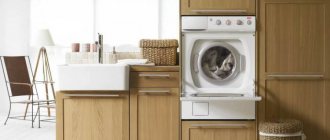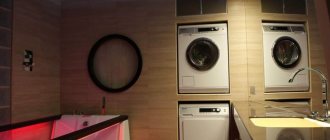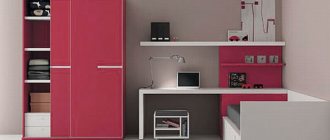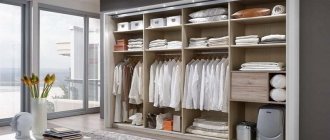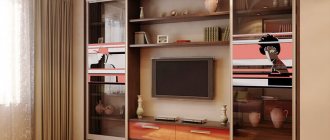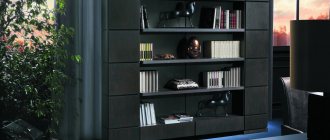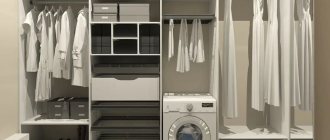Large household appliances, compact furniture, small space are an eternal problem faced by apartment owners. Traditionally, the layout of a living space includes a small kitchen, bathroom or toilet. Therefore, there are few options left for placing the washing machine. To arrange household appliances compactly, beautifully and conveniently, you can use a built-in or stationary cabinet for a washing machine. The product is made to individual sizes, which eliminates difficulties with using the unit and problems during installation.
Purpose
Saving space is a decisive factor when choosing furniture for large built-in appliances. A competent project and original design of the cabinet model allow you to create the illusion of free space, as well as arrange products compactly and ergonomically. In most cases, washing machines are installed in the kitchen or bathroom, built into specially designated niches or modules. This cabinet helps solve the following problems:
- space saving. A pressing problem that almost all homeowners face is the compact installation of large household appliances. Installing a washing machine inside a cabinet frees up space in the room;
- aesthetic appeal of the work area. Regardless of which room the cabinet will be installed in (kitchen, bathroom), the room “wins” in aesthetics. Household appliances will not attract the attention of guests if you hide them behind beautiful furniture doors;
- rational use of free space. There are furniture models for household appliances with additional sections, shelves, and drawers. The internal content depends on the size of the installation space. Inside you can install baskets, nets, shelves for storing detergents;
- spectacular room design - furniture for rooms with high humidity can be made from moisture-resistant materials, the doors can be decorated with decorative facades, the product can be made in a suitable style so that all the furniture in the room looks like a single ensemble;
- maintaining order and ease of cleaning the room. The neat arrangement of equipment inside the cabinet simplifies the process of wet cleaning in the bathroom or kitchen. Housewives can put various personal hygiene items and household chemicals on the shelves.
An additional advantage of installing a washing machine in the interior of a cabinet is the sound insulation of operating equipment. As a rule, washing machines operate loudly on the spin option. The cabinet walls create some barrier to noise and vibration, performing a noise-absorbing and sound-insulating function. The top panel of a small cabinet built under the sink can be used as a convenient shelf for placing various accessories, small items, and hygiene products.
Recommendations and videos
More details:
- You should not install devices one on top of another just like that. This is a gross violation of operating rules and regulations and is therefore strictly prohibited.
- While the dryer is running, the washing machine should be turned off and vice versa.
- Do not forget that vibrating devices should not be placed close to the wall. There should be at least 3 cm between them.
- Two devices of the same brand are more convenient to use, and this option should be preferred.
- If it is impossible to purchase devices from the same company, they must still fit in size.
Installing washing machines and dryers in a column is a rational and simple way. It's not difficult to do this yourself. Before you start work, you need to study all the nuances. You should take care of the accessibility of communications, prepare a mount if necessary, and also carefully read the operating instructions for the device.
Kinds
The optimal solution for small rooms is a cabinet for a washing machine. If you draw up a successful project, you can find space to install internal shelves, cabinets, and a symmetrical arrangement of the drying machine. The design of the furniture depends on the availability of free space and the size of the washing machine. In modern housing, equipment is placed in the kitchen, bathroom, and hallway. These conditions determine the design features of cabinet models, the choice of materials and decoration, and the design of doors, if they are provided for in the design drawing.
According to the material of manufacture
To install a washing machine, you need to take into account the humidity of the room when choosing materials for making furniture. Installing equipment in the hallway allows you to implement any solution, but for the bathroom you need moisture-resistant materials with a long service life. Another important point is the dimensions and weight of the machine. To install heavy models, it is necessary to use durable base materials, high-quality fittings, and stable structures. Types of cabinets for washing machines according to the material they are made of:
- MDF boards are a standard solution for the kitchen and hallway, but in the bathroom furniture parts at the joints are exposed to moisture and do not last long. An MDF cabinet can be given any shape, choose an interesting color scheme, or use spectacular decor;
- natural wood treated with special moisture-repellent compounds. Wooden cabinets fit perfectly into the interior; they are distinguished by their noble shade and environmental friendliness of the natural material. Furniture made from natural wood is stable and durable, but does not tolerate moisture;
- glass combined with metal is an interesting solution for installing built-in units. The washing machine behind the glass doors looks unusual, neat, and expensive. Modern glass processing technologies give the material additional strength, hardening, texture, matte, satin effect;
- plastic cabinet is a ready-made option. Such models are not uncommon in houses and apartments due to their low cost of products. Plastic does not deteriorate from exposure to moisture, and mold and mildew do not appear on it. You can choose a cabinet for a washing machine of any color. A significant disadvantage of plastic furniture is its fragility;
- furniture panel is an unusual, but completely justified option for installing a washing machine in the kitchen or hallway. Furniture board is a natural material made from oak, beech, ash, and birch wood. The tree is cut into small strips, which are securely glued together. The shield is durable, strong, beautiful.
The materials used to manufacture cabinets for built-in appliances must meet the operating conditions of the furniture. Moisture-resistant materials are suitable for wet rooms; in rooms with normal humidity and stable temperature conditions, you can install furniture from any materials. Functional content, equipment, and installation location are of great importance.
Wood
MDF Glass
Chipboard
By location
There are not many places in an apartment, house, or country house where you can install a cabinet for a washing machine. Of course, at the whim of the homeowner, equipment can be placed even in the living room, but such a solution is irrational, aesthetically unattractive and impractical. To install large equipment, you need to select suitable furniture and install the product in the most convenient place. There are only four acceptable options for installing washing machines in a closet - bathroom, kitchen, hallway, toilet (extremely rare). In addition, furniture can be arranged in different ways in the free space:
- wall-mounted option - the cabinet does not touch the floor with its legs, it has a countertop under which the washing machine is placed. On one side of the furniture structure there are drawers or shelves. There are no doors, the model is suitable for mounting front-loading machines. It’s difficult to call furniture a full-fledged closet, but the solution is often implemented in narrow bathrooms, combining appliances, a sink, and shelves. Another option is to mount an oversized washing machine with a small load on the wall;
- a base cabinet is the most common way to integrate household appliances. The free-standing design allows you to hide communications, a washing machine, and place hanging shelves, racks, and other furniture above it. Suitable for completing bathrooms, kitchens, corridors. If the room's capabilities allow you to install doors, the unit will not become dusty or dirty. A small cabinet is sometimes called a washing machine cabinet due to the compact size of the product;
- tall cabinet column (pencilcase) built-in or stationary type. The model is placed in a narrow space of a bathroom, kitchen, or less often a hallway. The lower part of the furniture is used to install a washing machine, on which a dryer is mounted. On the mezzanine tier there are shelves for storing household chemicals, bath textiles, cosmetics and other necessary items. The upper module can be equipped with hinged doors;
- module or niche of a kitchen unit. Options for permanent installation of furniture, full or partial embedding are allowed. When fully built-in, the machine can be hidden behind the front doors, giving the room a neater look, the effect of a spacious room. There is a wide choice of installation of appliances - the end of a kitchen unit, a bar counter, if the machine is vertical loading, a module with closed doors. When partially built-in, the equipment is placed under the tabletop in a free niche.
In a narrow hallway, you can install a built-in wardrobe across the width of the room, place a washing machine in the lower part, and use the upper tier to install a mirror with lamps, shelves, and a mezzanine for accessories. Based on their location, cabinets for washing machines are conventionally classified into floor-mounted, wall-mounted, column-mounted (pencil cases), cabinets, and based on the installation method - free-standing stationary-type models, fully or partially built-in furniture.
Column Floor
Modular
By design
The design of cabinets for built-in appliances is determined by the size of the furniture and the installation location. At the same time, the aesthetics of the model should correspond to the overall style and design of the room. Ready-made furniture for washing machines can only be conveniently placed in large rooms. A variety of design ideas can be realized in custom-made projects. The most popular cabinet design solutions:
- corner design - two sides of the cabinet are in contact with adjacent walls of the room, two more serve as front panels. One front panel can be equipped with doors, and the second can be left open to accommodate a washing machine and shelves;
- straight built-in wardrobe from floor to ceiling with two or three sections. An open niche is left in the lower left or right corner for installing a washing machine. The model will fit compactly in the hallway;
- narrow cabinet for installation in a bathroom with extension. The lower part of the furniture accommodates a washing machine, closed with doors; in the upper superstructure there is a mirrored cabinet with shallow shelves for small items;
- vertical cabinet for installing equipment with a front loading drum. The furniture belongs to the classic free-standing stationary type products. Depending on the availability of free space, the product is equipped with one or two doors;
- In most cases, the horizontal floor option is installed along the length of a free wall, combined with a sink and functional shelves. The machine can be closed with doors or located in an open niche.
When choosing a cabinet design, you need to consider the presence of doors. If the furniture is equipped with hinged doors, there should be enough space for the doors to open freely.
In a small area, you can install a cabinet with folding fronts or hang a panel that moves along the top guide like a sliding compartment system. Too narrow rooms require a non-standard approach to installing equipment - it is convenient to use a cabinet with a washbasin built into the countertop.
Vertical
Horizontal
Straight
Angular
To size
The cabinet for installing appliances is made according to the dimensions of the washing machine. The dimensions of the model are the starting point when choosing the design, shape, and size of furniture. All automatic machines are classified into vertical (top loading) and horizontal (front drum) units. This must be taken into account when designing furniture. In addition, models of equipment can be built-in, with removable top covers, or free-standing. You can place any washing machine in the interior space of the cabinet if you correctly calculate the dimensions of the equipment and connect the communications. Features of calculating furniture dimensions based on unit dimensions:
- frontal full-size model - standard height is 890-900 mm, there are options with a height of 850 mm. The depth of the machine is standard 600 mm, there are narrower models with a smaller drum capacity - 350-400 mm, ultra-narrow ones - 320-350 mm. At the same time, almost all frontal models have a width of 600 mm, except for compact copies (680-700x430-450x470-500 mm);
- The overwhelming majority of vertical models have a significant height of 850-900 mm, compact dimensions in depth - 600 mm and width - 400 mm. When installing vertical models, no additional space is required on the front side of the cabinet, that is, in the area of the doors. Often the convex hatch of the drum prevents the installation of front-facing equipment - there are no such problems with vertical units;
- The dimensions of the cabinet must correspond to the dimensions of the equipment with an additional gap between the walls of the furniture and the body of the machine of 20-30 mm, so that when vibration occurs during the spin cycle, the unit does not break the furniture structure. It is not recommended to install a cabinet with a plinth - the equipment will vibrate, gradually moving to the side, front or back walls of the furniture;
- installation of horizontal cabinets involves installing furniture under sinks in the bathroom. Then a compact machine (700x450x500 mm) is suitable for installation. If the unit is installed under a kitchen worktop, its height must be at least 1000 mm - the tabletop does not lie on the body of the machine, but is attached to the rear wall. For vertical units, you need to leave room for opening the hatch;
- installation of cabinets of a vertical design allows you to install a module measuring from floor to ceiling, but the width of the product must be at least 650 mm, the depth varies from 350 mm (narrow appliances) to 650 mm (deep front models). For vertical units, a height of 850-900 mm and a cabinet depth of 600 mm plus a gap of 20-30 mm on the side are required.
Manufacturers of built-in appliances indicate dimensions for installation in the instructions. If you need to install a stationary unit, the furniture is made according to the dimensions of the machine, taking into account the space for the convex drum hatch if the model is mounted behind closed facades. To compensate for the corners of the room and the furniture set, it is convenient to install a structure with radius doors; select a washing machine with a convex front panel and place it in a cabinet niche.
Choosing a location for installation
The rules for installing built-in equipment require proper connection of communications. In this regard, it is most convenient to install the washing machine in the kitchen or bathroom - there is a water supply nearby and a sewer for drainage. If the installation is carried out in a corridor, you must first wire the system and then install the cabinet. It is possible to equip a separate laundry room only in large houses/apartments. Basic rules for choosing an installation location:
- The best option is the bathroom. The idea can be implemented in several ways: remove the bathroom, in its place put a shower stall and a vertical cabinet under the washing machine (the material of the cabinet must be moisture resistant), mount a corner structure with additional modules, shelves, install compact appliances under the washbasin - sinks are mounted in the countertop or installed above;
- A rational idea is to install a washing machine in the kitchen. In a spacious room, the cabinet is mounted separately. In a small room they make a work area with a dryer and a machine on one side of the line, a dishwasher, a microwave, other kitchen appliances on the other side, the central part is a sink, wall cabinets for dishes. Another option is to install the front machine at the end of the headset;
- A practical solution is to install a cabinet with a washing machine in the hallway (corridor). If the room is narrow, built-in furniture along the entire length of the “short” wall is suitable - functional and simple. The square corridor is equipped with a wide straight or narrow corner structure so that opening the cabinet does not interfere with entering/exiting the room. In the hallway, the unit is covered with facades, otherwise the machine looks out of place and unattractive;
- a situation without an alternative - installing furniture in the toilet. It’s easy to imagine a free-standing machine in the bathroom, but a closet is a serious matter. There are few solutions - a cabinet for compact appliances in the corner, you can install an upper cabinet above the washing machine and hide various accessories, toiletries, detergents, and household chemicals on the shelves.
Despite the fact that washing machines are difficult to fit into small rooms, the equipment fits well into furniture with a built-in installation option. This allows you to free up space, carefully arrange the washing unit, and use the space to maximum benefit. It is important that the cabinet can be made to fit any size of equipment, give the product an interesting appearance, and fit organically into the decor of the room.
Myth 9. Drying spoils items made from delicate fabrics.
In the new Candy models, drying is implemented using a heat pump, that is, a lower temperature is used than in condensing machines. This in turn does not wear things out, as already stated. Also, let's not forget about special drying modes, for example, the mode for wool - they are designed specifically for delicate fabrics.
In addition, modern washer-dryers are equipped with a steam mode, which not only saves electricity, but also helps to carefully wash delicate fabrics: steam treatment resembles boiling in its effect, but colored fibers retain their color. By the way, steam also disinfects clothes quite well, which is very important for children's clothes or things for people with allergies.
Niches for linen
Every housewife is interested in the issue of practical, compact placement of household appliances. But we must not forget about the details - somewhere you need to put dirty laundry, put detergents, store bath and toiletries. It is customary to leave such things in the bathroom, so niches for linen are installed in this room. To compactly place both the washing machine and the functional elements of filling the cabinet, you can make the structure as follows:
- mount a vertical cabinet cabinet, install equipment in the lower part of which, and use the upper module for a built-in basket;
- equip a horizontal cabinet with a cabinet, sinks in this option are embedded in the tabletop, use one part of the furniture (left or right) as a niche for linen;
- a hanging cabinet model, in which appliances are installed on the floor, can be equipped with a spacious niche for a basket. It is still recommended to close it with doors.
Of course, you can equip built-in baskets in the kitchen or hallway, but in the first case, things will be additionally saturated with food odors, and in the second, you should not combine clean outerwear in the hallway compartment next to the niches for storing dirty linen and home textiles. In addition, baskets outside the bathroom look untidy.
Installing equipment in a closet is an ideal solution for small rooms and spacious rooms. Washing machines do not create as much noise when operating if the units are located behind closed doors. You can equip a bathroom, kitchen, hallway or toilet with built-in furniture. Manufacturing products to individual sizes allows you to carefully place units with vertical and horizontal loading.
Benefits of using a drying machine
Before using the machine to dry washed clothes, you need to familiarize yourself with the advantages of these devices. The advantages of dryers include the following:
- The process of drying clothes is carried out very quickly and efficiently. After this, you don’t even have to hang things up to dry.
- The functional features of the devices allow you to dry clothes to the required level of humidity. This allows you to efficiently dry things made from capricious fabrics.
- The evaporation of moisture inside the dryers helps smooth the fabric. Therefore, there is no need to iron them again.
- Possibility of refreshing linen. This allows you to get rid of unpleasant odors that are embedded in the fabric.
However, such devices also have some disadvantages that you need to familiarize yourself with before purchasing and using them:
- high cost of modern models;
- bulkiness, due to which a lot of space will be required to install the dryer.
